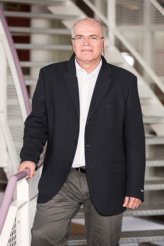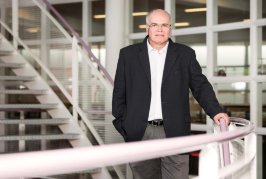Interview with Oded Gottlieb: Chaos theory applications in engineering science since the seventies
Interview by Kees Versluis
Photo by Marc Blommaert
 Mr.Gottlieb applies chaos theory to solve typical engineering problems, from building windmills at sea to the improvement of the atomic powered microscope (AFM). The Israeli civil engineer Oded Gottlieb was invited by 3.TU.AMI to hold a keynote lecture during the Spring Congress in Utrecht on the 21st of May.
Mr.Gottlieb applies chaos theory to solve typical engineering problems, from building windmills at sea to the improvement of the atomic powered microscope (AFM). The Israeli civil engineer Oded Gottlieb was invited by 3.TU.AMI to hold a keynote lecture during the Spring Congress in Utrecht on the 21st of May.
“I’m an engineer who loves mathematics”, says Gottlieb significantly. That is rather special, he means to say. Because mostly the reverse holds true: most mathematical whizzes in engineering science are mathematicians who were not able to get an appointment in their own field and therefore switched.
Gotllieb studied civil engineering at the technical university of Haifa, Technion (sometimes called the “MIT of Israel”) . He was convinced he would end up in industry just like his father. But it turned out differently. At the end of his study he fell in love: with chaos theory.
“I read the book ‘Instabilities and catastrophes in science and engineering’ of Michael Thompson, which my supervisor at Technion turned up with. During my undergraduate education at the beginning of the eighties I had never studied anything about chaos theory. I was seized by the global effects which chaos could have in nature, that a waving hand very far away in the end can have influence on a window we are looking through here.”
At the beginning of the eighties chaos theory was a new discipline, borne twenty years before with the famous article ‘Deterministic Non periodic Flow’ (1963) of the American meteorologist Edward Lorentz. He discovered by accident that a tiny difference in the initial condition of the atmosphere can bring about completely different weather after some time (the famous metaphor of the butterfly flapping its wings in Brazil - affecting the weather pattern – causing a tornado in Texas a few months later.
The article of Lorentz caused a landslide in the exact science. At the time one thought that small changes would result in small consequences. This was not true, there exist physical systems (such as flows in liquids or motions of a pendulum) which are unpredictable, no matter how well the computer calculates.
Gottlieb: “Since the seventies chaos theory entered into the engineering science, especially into electrical engineering, mechanics and aerospace engineering. After that it was used in computer science with its famous fractals with which its databases could be compressed.”
Because hardly any research was done in chaos theory in Israel, Gottlieb and his wife decided to move to the United States – the love for the new theory was deep. Gottlieb obtained his PhD degree on the subject and got a MIT-postdoc. And then his former university at Haifa offered him a professorship in this new discipline. “I’ve thought about it for a long time” Gottlieb said . After all, he was an engineer and actually preferred industry.
And now he is one of the greatest specialists in the application of chaos theory in typical engineering domains, e.g. windmill installations at sea. How deep do these have to be anchored in the seabed, so that they will turn safely in stormy weather? Chaos theory plays an important role in answering this question.
Or consider the atomic force microscope. The ‘common’ device pictures atomic landscapes because the needle of de microscope measures the “Vanderwaals” forces between the atoms. By moving the needle in a smart chaotic way across the material the microscope can disclose much more material properties than in the traditional way. “So my research is sometimes driven by avoiding chaos and sometimes - in case of the microscope - by using chaos.”
To be an engineer in a mathematical environment has a great advantage remarks Gottlieb: it makes fund raising for research easier. Not only industry endows his research regularly, but also (semi)governmental financiers are asking more and more for tangible applications before making money available. For pure mathematicians fund raising is much harder to do.
Still there is also a disadvantage, he admits: for his research he depends on the (short-term) vision/interest of his financiers. “But fortunately I have always been able to do what I wanted: I devise my own research problems and write my own research proposals for them. But apparently I cannot investigate everything. So I like to focus on research of the human heart: In heart failure chaos is playing an important role, there is a resemblance between these processes and those of the capsizing of a ship.”
Although nowadays every technical university will have at least one chaos specialist, the chaos theory still is a limited research field within engineering sciences. “That is not strange, because in the end it is a subdomain of a subdomain. Most research still takes place within the linear dynamical regime, not-linear dynamical systems form a smaller domain; chaotic systems even smaller still.
Engineering students having an interest in chaos, are advised by Gottlieb to read the book of Francis J. Moon: ‘Chaotic Vibrations: An Introduction for applied Scientists and Engineers’ . “The introduction is very accessible for bachelor students, actually you only need secondary school mathematics and some knowledge of linear algebra.” Five years ago the BBC created a good one hour movie for laymen: ‘The secret life of chaos’.
This film has a touch of the romantic connotation which the chaos theory had in the seventies: chaos as liberation of the rule of science.
But with regard to this, chaos theory principally differs from quantum theory.
(interview vertaald door E. van Elderen)
Date: 21 May 2015
'Chaostheorie is sinds de jaren zeventig ver doorgedrongen in de ingenieurswetenschappen'
Interview by Kees Versluis
Photo by Marc Blommaert

Hij past chaostheorie toe om typische ingenieursproblemen op te lossen: van de bouw van windmolens op zee tot verbetering van de atoomkrachtmicroscoop (AFM). De Israëlische civieltechnicus Oded Gottlieb hield daarover een key note lecture tijdens het 3TU.AMI Spring Congress in Utrecht op 21 mei.
‘Ik ben een ingenieur die van wiskunde houdt’, zegt Gottlieb veelbetekenend. Dat is tamelijk bijzonder, wil hij maar zeggen. Want meestal is het andersom: ‘De meeste mathematische bollebozen in de ingenieurswetenschappen zijn wiskundigen die geen aanstelling konden krijgen in hun eigen vakgebied en daarom maar zijn uitgeweken.’
Gottlieb studeerde civiele techniek aan de technische universiteit Technion in Haifa (ook wel het ‘MIT van Israël’ genoemd). Hij was ervan overtuigd dat hij in de industrie zou belanden, net als zijn vader. Maar het liep anders. Gottlieb werd tegen het eind van zijn studie verliefd: op de chaostheorie.
‘Ik las het boek Instabilities and catastrophes in science and engineering van Michael Thompson. Mijn supervisor aan Technion kwam ermee aanzetten. In mijn undergraduate studie begin jaren tachtig had ik helemaal niets over chaos geleerd. Ik was gegrepen door de global effecten die chaos in de natuur kan hebben. Dat een zwaaiende hand heel ver weg uiteindelijk invloed kan hebben op het raam waar we hier nu doorheen kijken.’
Chaostheorie was begin jaren tachtig nog een jong vak, twintig jaar eerder geboren met het beroemde artikel Deterministic Nonperiodic Flow (1963) van de Amerikaanse meteoroloog Edward Lorenz. Hij had bij toeval ontdekt dat een miniem verschil in de begintoestand van de atmosfeer naar verloop van tijd totaal ander weer oplevert (de beroemde metafoor van de vlinder die in Brazilië met zijn vleugels klapt en daarmee maanden later in Texas een tornado veroorzaakt).
Dat artikel van Lorenz veroorzaakte een aardverschuiving in de exacte wetenschappen. De aanname was tot die tijd namelijk dat kleine veranderingen kleine gevolgen hebben. Dat bleek dus niet te kloppen; er bestaan fysische systemen (zoals stromingen in vloeistoffen of de beweging van een slinger) die na enige tijd onvoorspelbaar zijn, hoe goed de computer ook rekent.
Gottlieb: ‘Pas in de jaren zeventig drong chaostheorie door in de ingenieurswetenschappen, vooral in de elektrotechniek, mechanica en lucht- en ruimtevaarttechniek.’ Daarna bereikte het de informatica in de vorm van de bekende fractals, waarmee databestanden konden worden gecomprimeerd.
Omdat er in Israël in de jaren tachtig nog nauwelijks onderzoek plaatsvond naar chaos besloten Gottlieb en zijn vrouw naar de Verenigde Staten te gaan – de liefde voor de nieuwe theorie zat diep. Gottlieb promoveerde er op het onderwerp en werd postdoc aan MIT. En toen vroeg zijn oude universiteit in Haifa of hij daar hoogleraar wilde worden in het nieuwe vakgebied. ‘Ik heb daar lang over nagedacht’, zegt Gottlieb. Hij was tenslotte ingenieur en wilde eigenlijk naar het bedrijfsleven.
En nu is hij een van ’s werelds grootste specialisten in de toepassing van chaostheorie op typische ingenieursterreinen. Bij de bouw van windmolens op zee bijvoorbeeld. Hoe diep moeten die in de zeebodem verankerd zijn om ze bij harde wind verantwoord te laten doordraaien? Chaostheorie speelt een belangrijke rol bij de beantwoording van die vraag.
Of neem de atoomkrachtmicroscoop (atomic force microscope, AFM). De ‘gewone’ variant brengt atomaire ‘landschappen’ in kaart doordat de naald van de microscoop de Vanderwaalskrachten tussen atomen meet. Door de naald op een slimme manier ‘chaotisch’ over het materiaal te laten bewegen, kan de AFM veel meer materiaaleigenschappen meten dan op de traditionele manier. ‘Soms gaat het er in mijn onderzoek om hoe chaos te vermijden is, maar soms ook – zoals bij de AFM – hoe je chaos juist kunt gebruiken.’
Dat hij een ingenieur is in de wereld van wiskundigen heeft een groot voordeel, bekent Gottlieb: hij kan makkelijker aan geld komen voor zijn onderzoek dan collega’s. Niet alleen de industrie subsidieert zijn onderzoek regelmatig, ook (semi-)overheidsfinanciers vragen meer en meer naar concrete toepassingen voor ze geld beschikbaar stellen. ‘Voor zuiver wiskundigen is het veel moeilijker om onderzoeksgeld binnen te halen dan voor mij.’
Een nadeel heeft dat natuurlijk ook, erkent hij: hij is voor zijn onderzoek afhankelijk van die (vaak kortetermijn-)interesses van zijn financiers. ‘Toch heb ik gelukkig altijd kunnen doen wat ik wilde: ik bedenk mijn eigen wetenschappelijke problemen en schrijf daar mijn eigen onderzoeksvoorstellen bij. Maar ik kan inderdaad niet alles onderzoeken wat ik wil. Zo zou ik me graag storten op onderzoek naar het menselijk hart: bij hartfalen speelt chaostheorie een belangrijke rol, het vertoont gelijkenissen met de chaotische processen bij het kapseizen van een schip.’
Hoewel iedere technische universiteit tegenwoordig ten minste één chaosspecialist in huis heeft, blijft chaostheorie een beperkt onderdeel van de ingenieurswetenschappen. ‘Dat is niet zo raar, want het is uiteindelijk een subdomein van een subdomein. Het meeste onderzoek vindt nog steeds plaats binnen lineaire dynamische systemen. Niet-lineaire dynamische systemen vormen een kleiner domein; chaotische systemen een nog kleiner.’
Techniekstudenten die interesse hebben in chaos raadt hij het boek aan van Francis J. Moon: Chaotic Vibrations: An Introduction for Applied Scientists and Engineers. ‘De inleiding is voor bachelorstudenten uitstekend te volgen, je hebt er eigenlijk alleen middelbareschoolwiskunde en wat kennis van lineaire algebra voor nodig.’ Voor leken maakte de BBC vijf jaar geleden een goede film van een uur: The secret life of chaos.
Die film heeft overigens nog wel een zweem van de romantische connotatie die chaostheorie vooral in de jaren zeventig had: chaos als ‘bevrijding’ van de wetmatigheid van de natuurwetenschap. Maar wat dat aangaat verschilt chaostheorie principieel van kwantummechanica met zijn indeterministische aspecten. ‘Chaotische processen zijn deterministisch en niet stochastisch. Een minieme verandering in de begintoestand van een systeem heeft uiteindelijk grote gevolgen, maar het blijft deterministisch.’
Datum: 21 mei 2015



